Abstract
1. Impulse activities of thirty-eight muscle spindle and tendon organ afferents from the finger extensor muscles were recorded in the radial nerve of human subjects while the subjects performed voluntary flexion and extension finger movements at a single metacarpophalangeal joint. 2. The afferent firing was analysed in relation to the 8-10 Hz discontinuities which previously have been shown to characterize these movements. Spike-triggered averaging and frequency domain analyses demonstrated that all Ia muscle spindle afferents and a large proportion of group II spindle afferents responded in close association with local peaks in the joint acceleration. During muscle lengthening the impulses appeared during phases of rapid muscle stretch, whereas they appeared during the phase of minimal speed during muscle shortening. 3. The Golgi tendon organ (Ib) afferents displayed a reverse pattern of activity in relation to the discontinuities, i.e. the impulses tended to appear in the phase of minimal speed during lengthening movements and close to maximal shortening speed during shortening movements. Hence, their firing often coincided with the phasic increases of the parent muscle activity which account for the 8-10 Hz discontinuities. 4. A close analysis of the time relations between spindle firing and the kinematics of the 8-10 Hz discontinuities revealed that the population spindle response was too delayed and too dispersed to support the hypothesis that the discontinuities are accounted for by the stretch reflex. 5. If, as suggested in a previous paper, the 8-10 Hz discontinuities are produced by a pulsatile descending motor command, the coding of the periodic but tenuous kinematic events by the population of proprioceptors may have a role in relation to an alleged pulsatile command generator.
Full text
PDF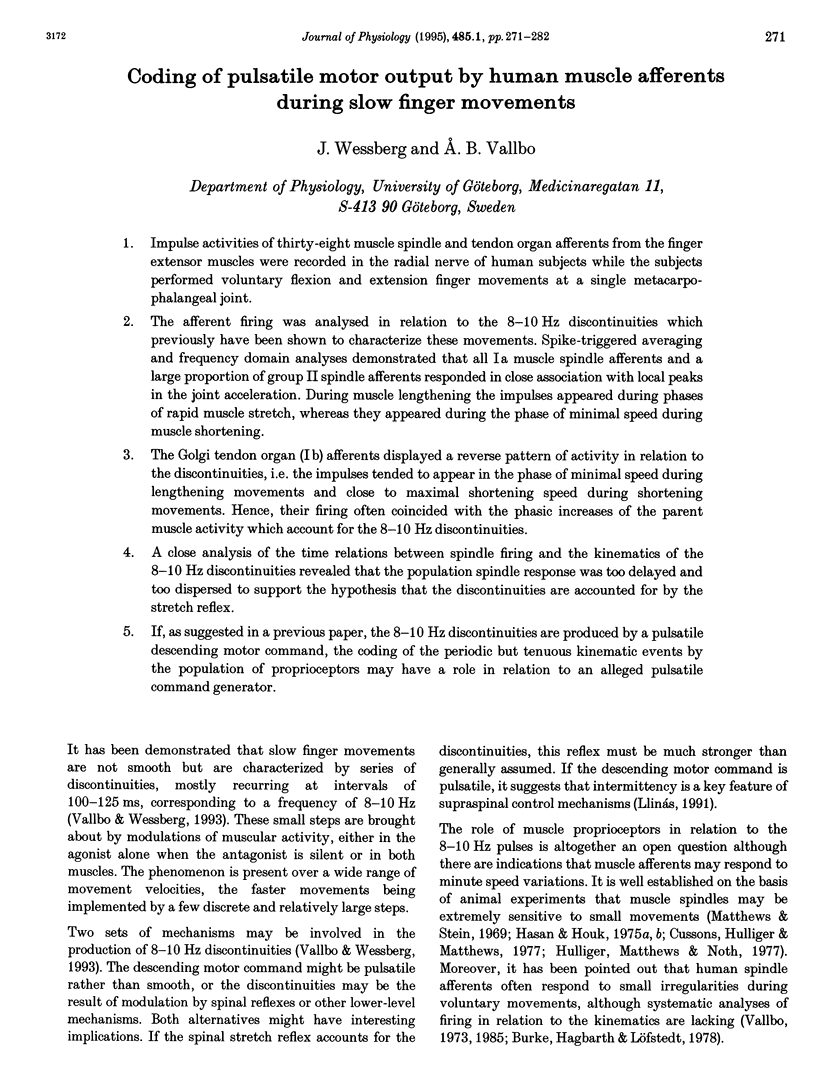
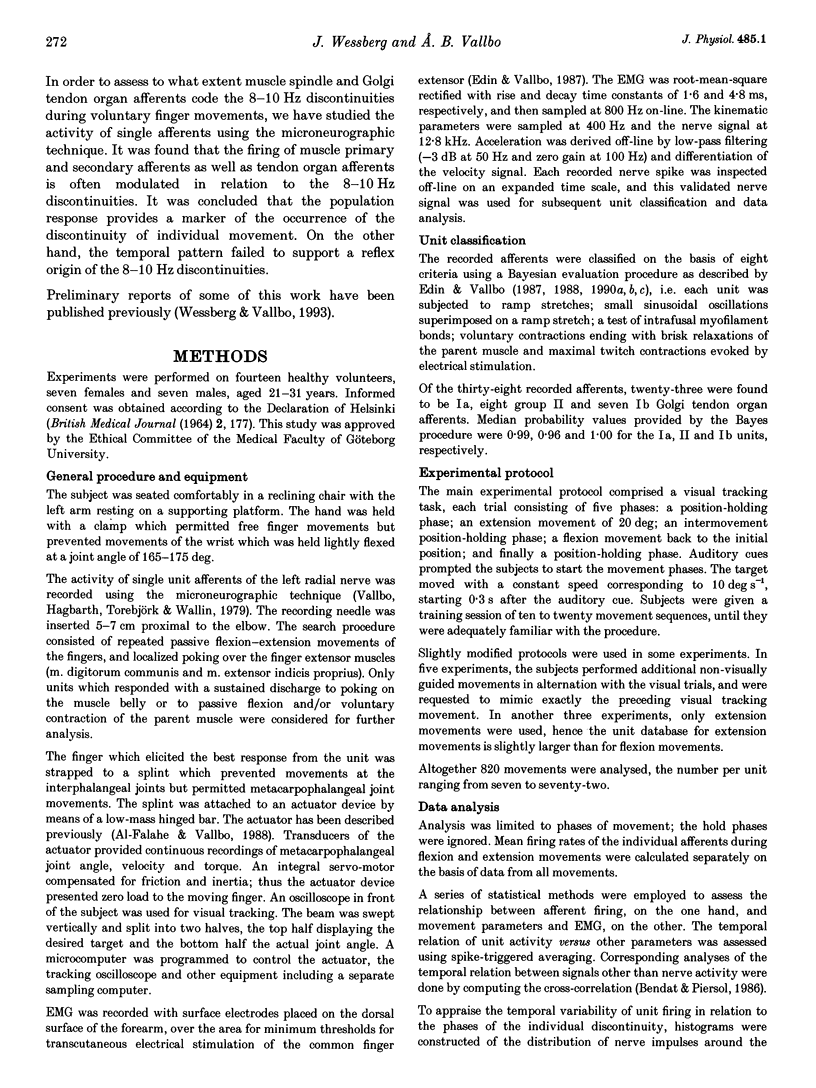
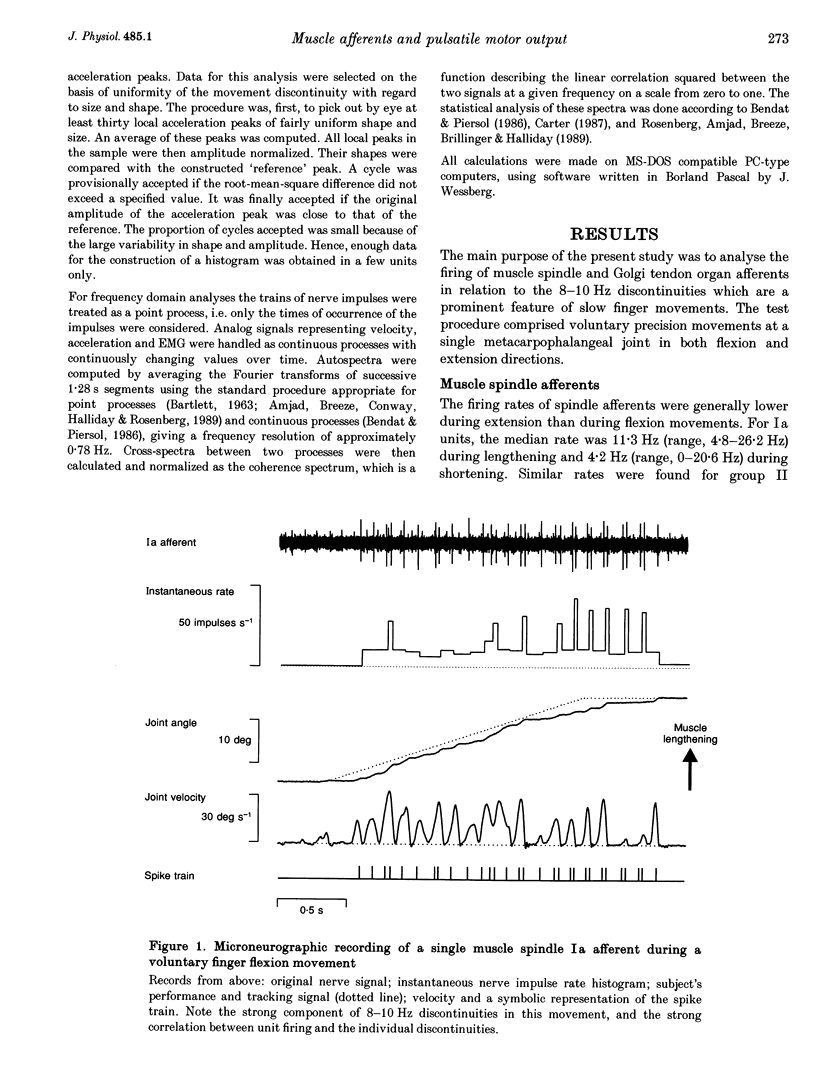
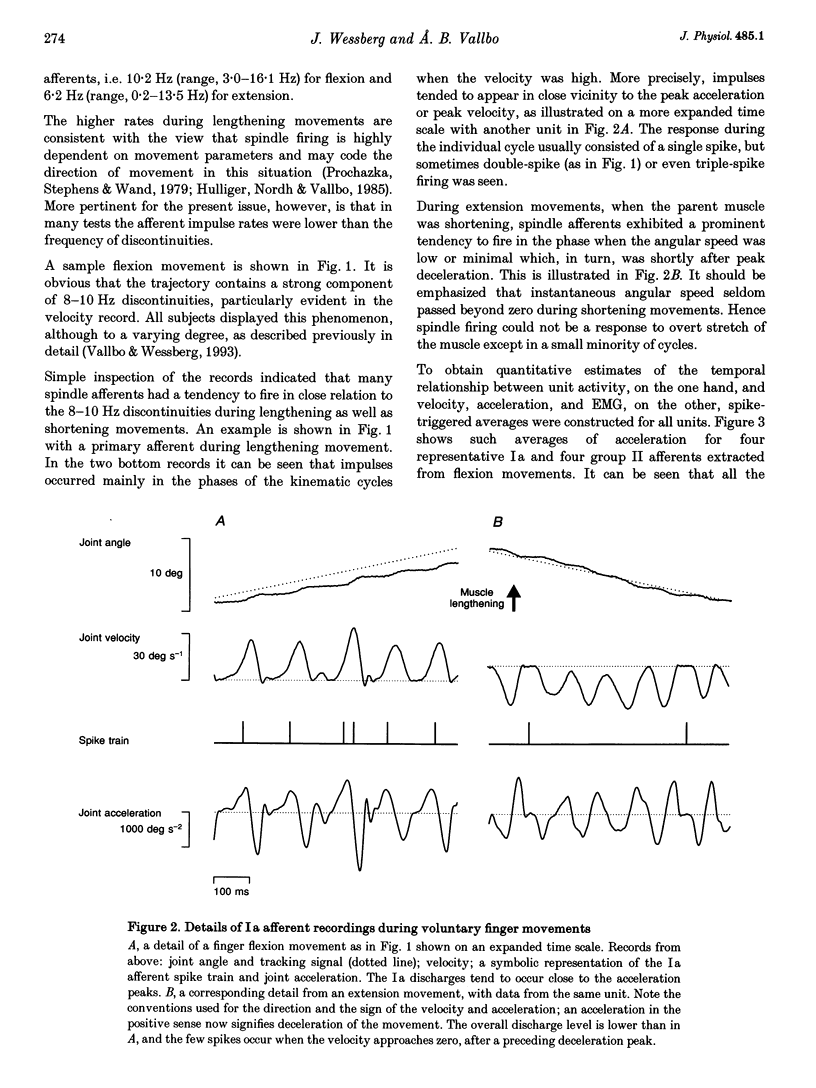
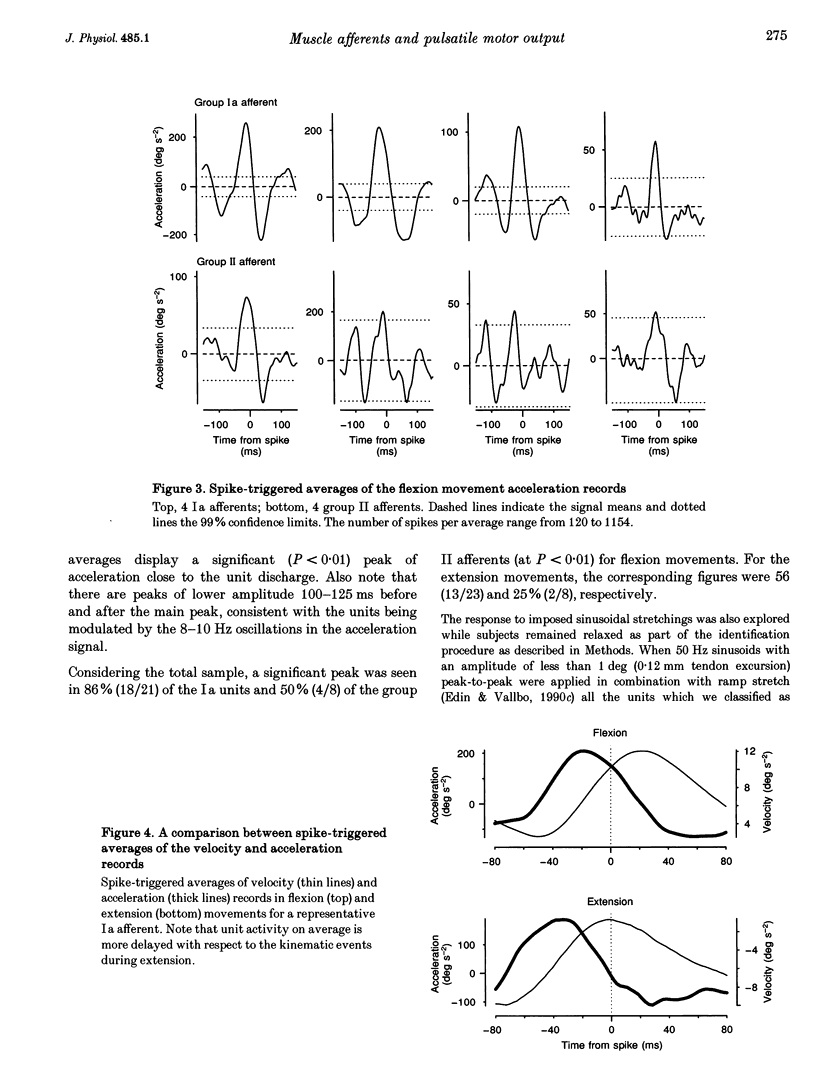

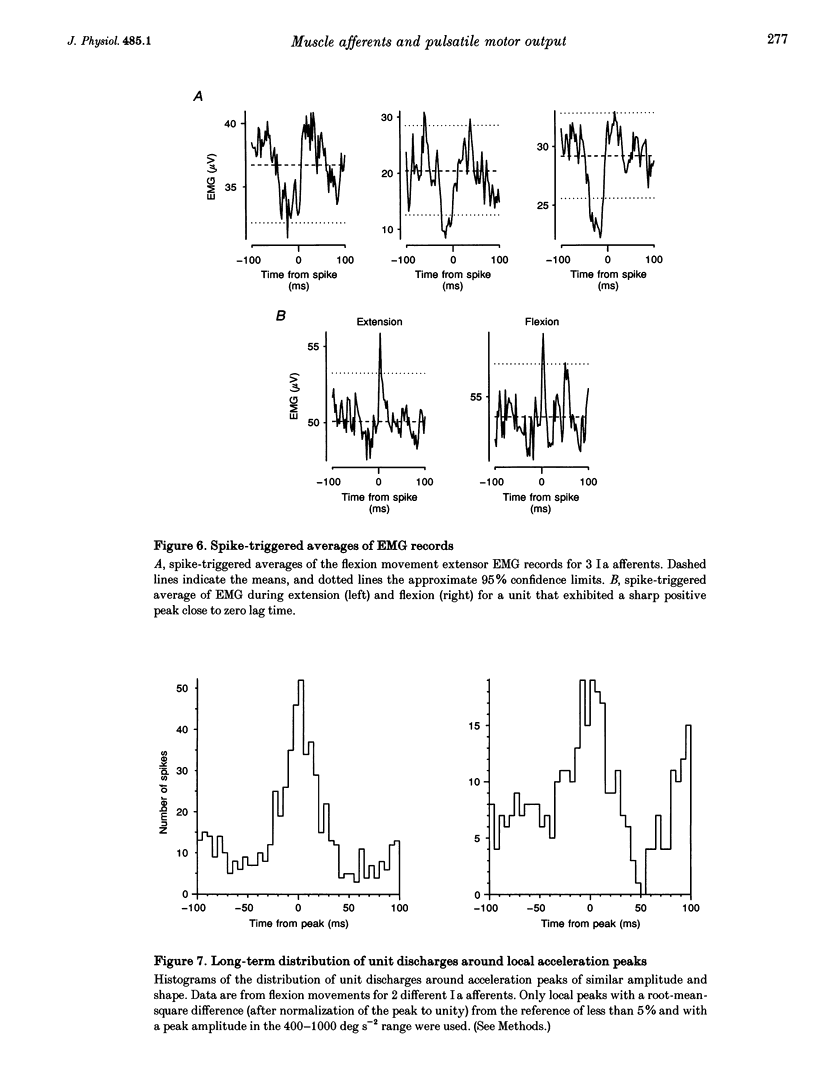
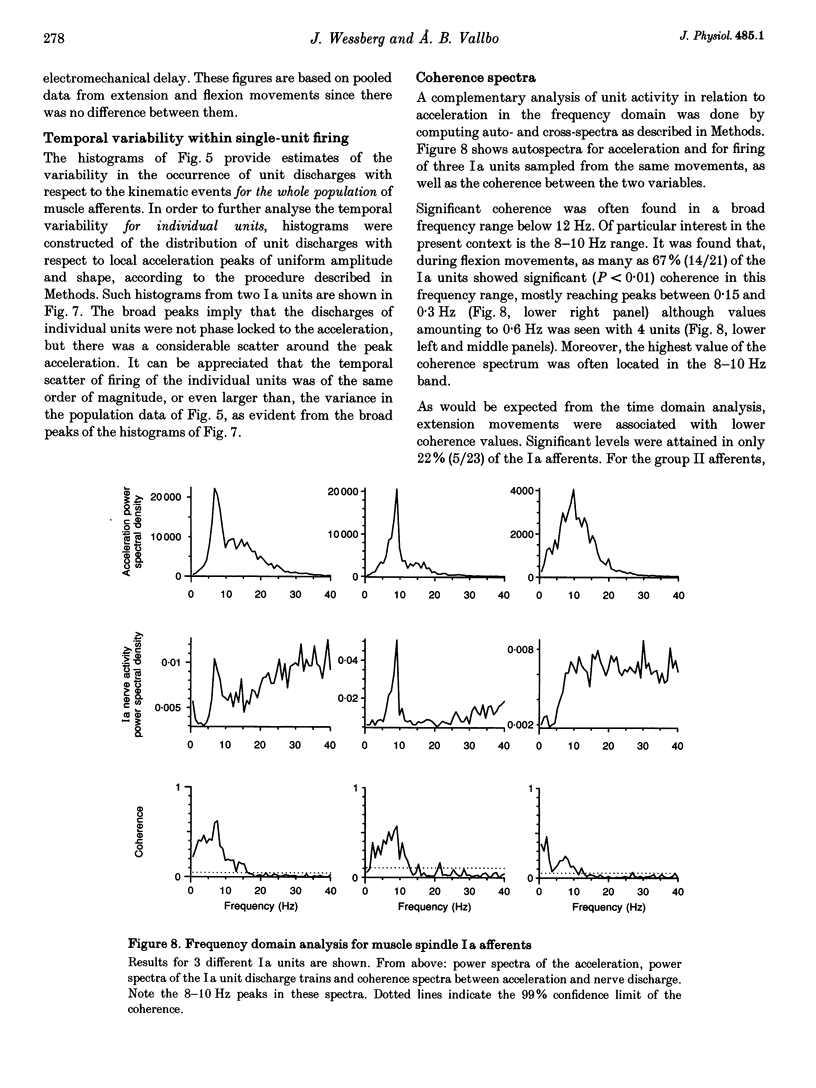
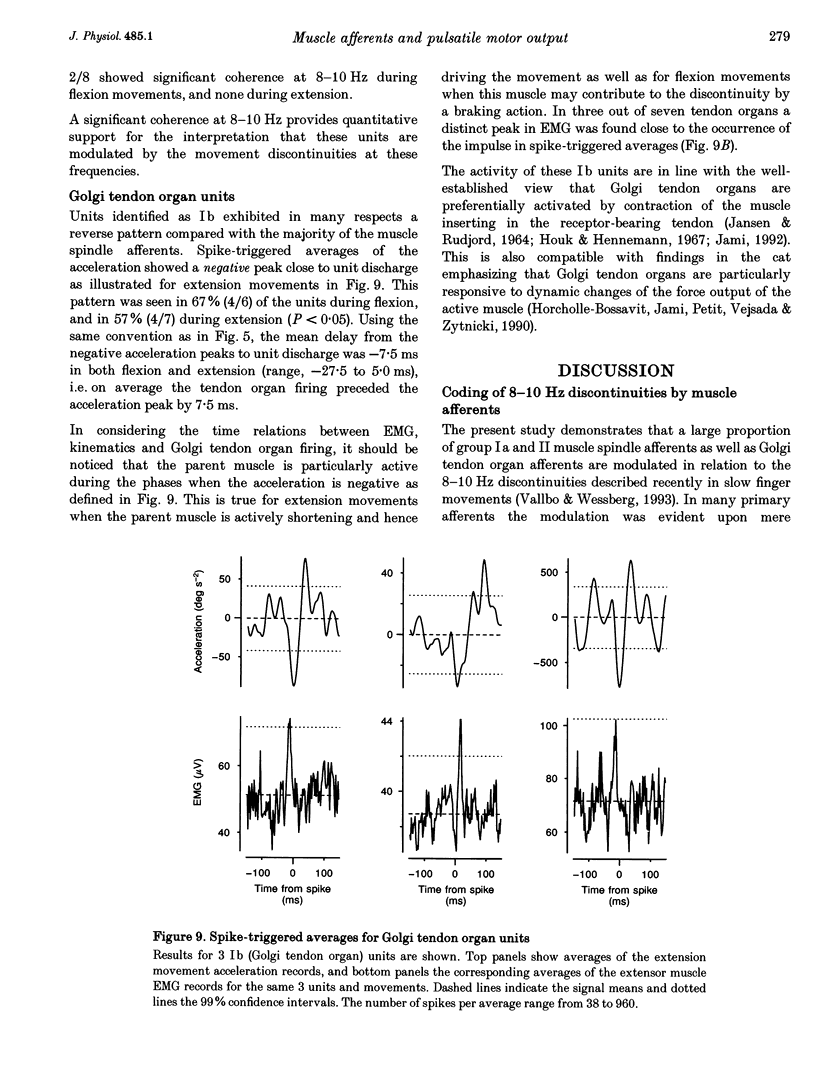
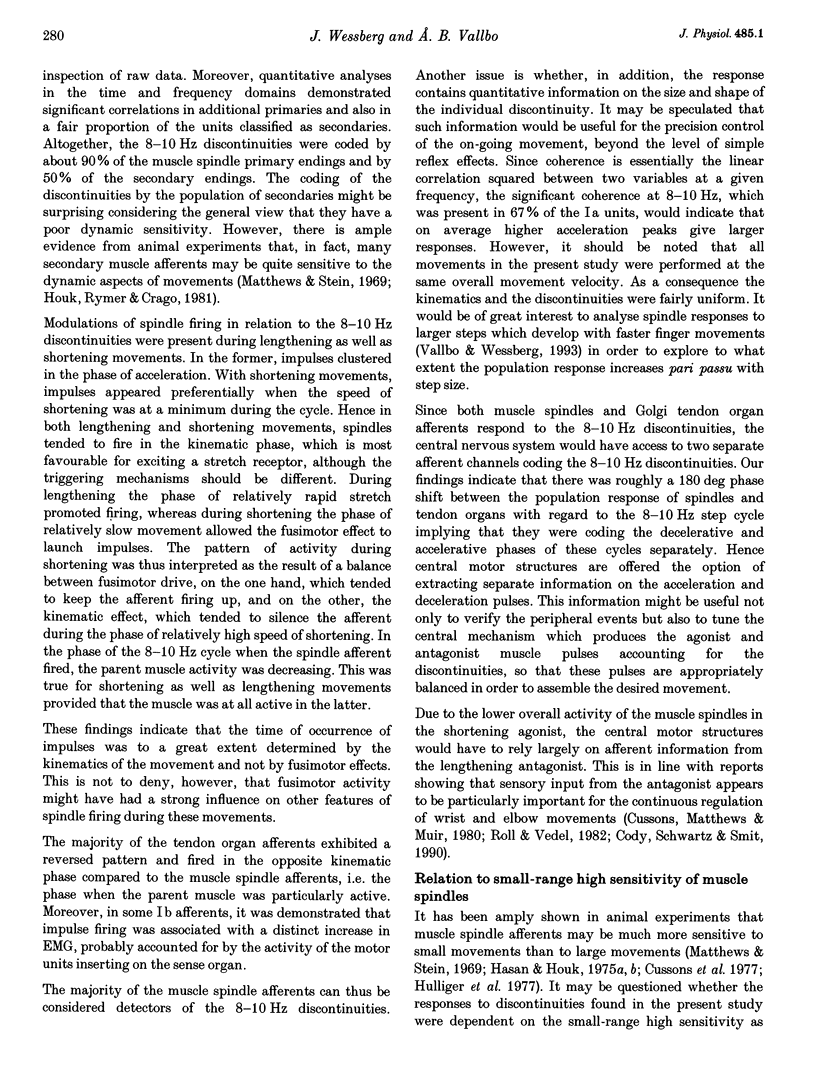
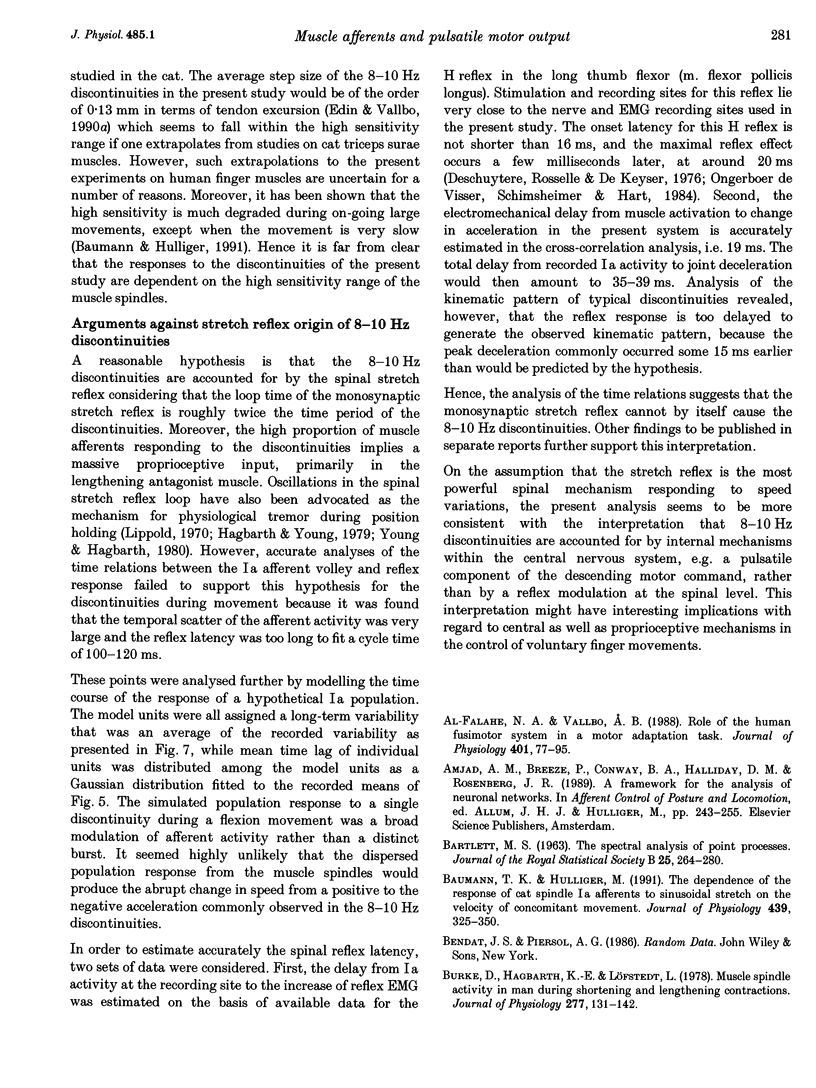
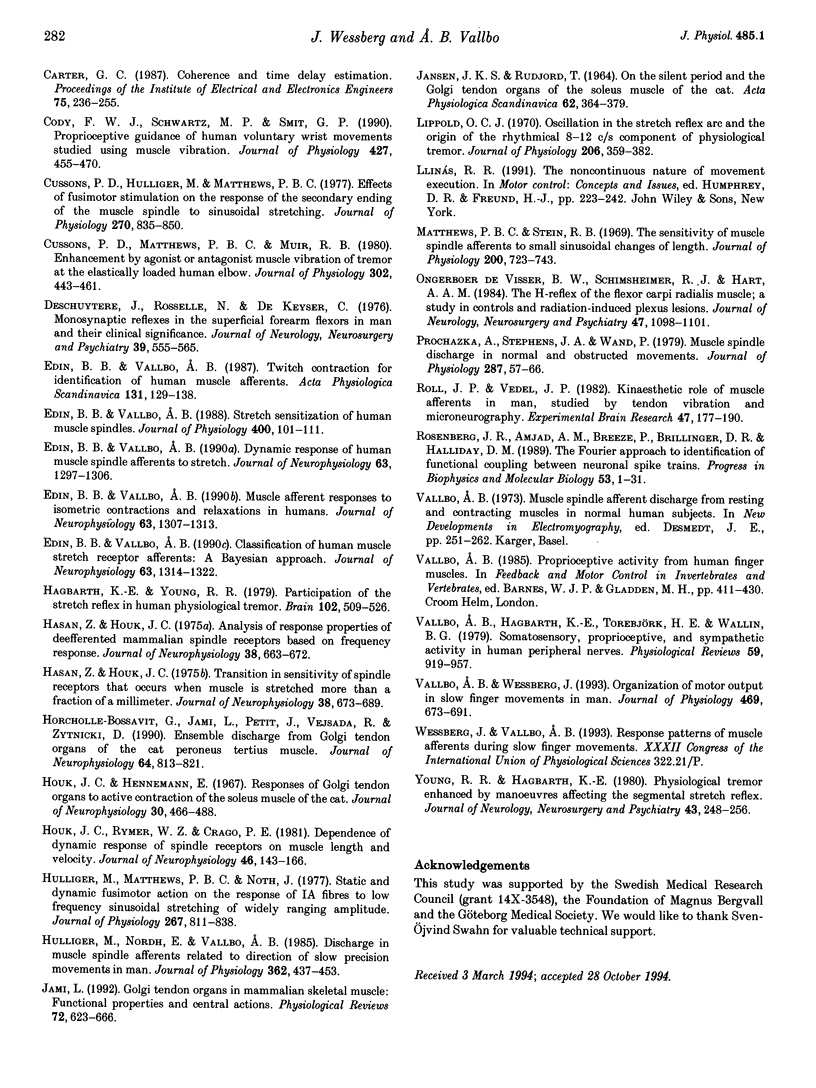
Selected References
These references are in PubMed. This may not be the complete list of references from this article.
- Al-Falahe N. A., Vallbo A. B. Role of the human fusimotor system in a motor adaptation task. J Physiol. 1988 Jul;401:77–95. doi: 10.1113/jphysiol.1988.sp017152. [DOI] [PMC free article] [PubMed] [Google Scholar]
- Amjad A. M., Breeze P., Conway B. A., Halliday D. M., Rosenberg J. R. A framework for the analysis of neuronal networks. Prog Brain Res. 1989;80:243–242. doi: 10.1016/s0079-6123(08)62218-9. [DOI] [PubMed] [Google Scholar]
- Baumann T. K., Hulliger M. The dependence of the response of cat spindle Ia afferents to sinusoidal stretch on the velocity of concomitant movement. J Physiol. 1991 Aug;439:325–350. doi: 10.1113/jphysiol.1991.sp018669. [DOI] [PMC free article] [PubMed] [Google Scholar]
- Burke D., Hagbarth K. E., Löfstedt L. Muscle spindle activity in man during shortening and lengthening contractions. J Physiol. 1978 Apr;277:131–142. doi: 10.1113/jphysiol.1978.sp012265. [DOI] [PMC free article] [PubMed] [Google Scholar]
- Cody F. W., Schwartz M. P., Smit G. P. Proprioceptive guidance of human voluntary wrist movements studied using muscle vibration. J Physiol. 1990 Aug;427:455–470. doi: 10.1113/jphysiol.1990.sp018181. [DOI] [PMC free article] [PubMed] [Google Scholar]
- Cussons P. D., Hulliger M., Matthews P. B. Effects of fusimotor stimulation on the response of the secondary ending of the muscle spindle to sinusoidal stretching. J Physiol. 1977 Sep;270(3):835–850. doi: 10.1113/jphysiol.1977.sp011984. [DOI] [PMC free article] [PubMed] [Google Scholar]
- Cussons P. D., Matthews P. B., Muir R. B. Enhancement by agonist or antagonist muscle vibration of tremor at the elastically loaded human elbow. J Physiol. 1980 May;302:443–461. doi: 10.1113/jphysiol.1980.sp013255. [DOI] [PMC free article] [PubMed] [Google Scholar]
- Deschuytere J., Rosselle N., De Keyser C. Monosynaptic reflexes in the superficial forearm flexors in man and their clinical significance. J Neurol Neurosurg Psychiatry. 1976 Jun;39(6):555–565. doi: 10.1136/jnnp.39.6.555. [DOI] [PMC free article] [PubMed] [Google Scholar]
- Edin B. B., Vallbo A. B. Classification of human muscle stretch receptor afferents: a Bayesian approach. J Neurophysiol. 1990 Jun;63(6):1314–1322. doi: 10.1152/jn.1990.63.6.1314. [DOI] [PubMed] [Google Scholar]
- Edin B. B., Vallbo A. B. Dynamic response of human muscle spindle afferents to stretch. J Neurophysiol. 1990 Jun;63(6):1297–1306. doi: 10.1152/jn.1990.63.6.1297. [DOI] [PubMed] [Google Scholar]
- Edin B. B., Vallbo A. B. Muscle afferent responses to isometric contractions and relaxations in humans. J Neurophysiol. 1990 Jun;63(6):1307–1313. doi: 10.1152/jn.1990.63.6.1307. [DOI] [PubMed] [Google Scholar]
- Edin B. B., Vallbo A. B. Stretch sensitization of human muscle spindles. J Physiol. 1988 Jun;400:101–111. doi: 10.1113/jphysiol.1988.sp017113. [DOI] [PMC free article] [PubMed] [Google Scholar]
- Edin B. B., Vallbo A. B. Twitch contraction for identification of human muscle afferents. Acta Physiol Scand. 1987 Sep;131(1):129–138. doi: 10.1111/j.1748-1716.1987.tb08214.x. [DOI] [PubMed] [Google Scholar]
- Hagbarth K. E., Young R. R. Participation of the stretch reflex in human physiological tremor. Brain. 1979 Sep;102(3):509–526. doi: 10.1093/brain/102.3.509. [DOI] [PubMed] [Google Scholar]
- Hasan Z., Houk J. C. Analysis of response properties of deefferented mammalian spindle receptors based on frequency response. J Neurophysiol. 1975 May;38(3):663–672. doi: 10.1152/jn.1975.38.3.663. [DOI] [PubMed] [Google Scholar]
- Hasan Z., Houk J. C. Transition in sensitivity of spindle receptors that occurs when muscle is stretched more than a fraction of a millimeter. J Neurophysiol. 1975 May;38(3):673–689. doi: 10.1152/jn.1975.38.3.673. [DOI] [PubMed] [Google Scholar]
- Horcholle-Bossavit G., Jami L., Petit J., Vejsada R., Zytnicki D. Ensemble discharge from Golgi tendon organs of cat peroneus tertius muscle. J Neurophysiol. 1990 Sep;64(3):813–821. doi: 10.1152/jn.1990.64.3.813. [DOI] [PubMed] [Google Scholar]
- Houk J. C., Rymer W. Z., Crago P. E. Dependence of dynamic response of spindle receptors on muscle length and velocity. J Neurophysiol. 1981 Jul;46(1):143–166. doi: 10.1152/jn.1981.46.1.143. [DOI] [PubMed] [Google Scholar]
- Houk J., Henneman E. Responses of Golgi tendon organs to active contractions of the soleus muscle of the cat. J Neurophysiol. 1967 May;30(3):466–481. doi: 10.1152/jn.1967.30.3.466. [DOI] [PubMed] [Google Scholar]
- Hulliger M., Matthews P. B., Noth J. Static and dynamic fusimotor action on the response of Ia fibres to low frequency sinusoidal stretching of widely ranging amplitude. J Physiol. 1977 Jun;267(3):811–838. doi: 10.1113/jphysiol.1977.sp011839. [DOI] [PMC free article] [PubMed] [Google Scholar]
- Hulliger M., Nordh E., Vallbo A. B. Discharge in muscle spindle afferents related to direction of slow precision movements in man. J Physiol. 1985 May;362:437–453. doi: 10.1113/jphysiol.1985.sp015687. [DOI] [PMC free article] [PubMed] [Google Scholar]
- JANSEN J. K., RUDJORD T. ON THE SILENT PERIOD AND GOLGI TENDON ORGANS OF THE SOLEUS MUSCLE OF THE CAT. Acta Physiol Scand. 1964 Dec;62:364–379. doi: 10.1111/j.1748-1716.1964.tb10435.x. [DOI] [PubMed] [Google Scholar]
- Jami L. Golgi tendon organs in mammalian skeletal muscle: functional properties and central actions. Physiol Rev. 1992 Jul;72(3):623–666. doi: 10.1152/physrev.1992.72.3.623. [DOI] [PubMed] [Google Scholar]
- Lippold O. C. Oscillation in the stretch reflex arc and the origin of the rhythmical, 8-12 C-S component of physiological tremor. J Physiol. 1970 Feb;206(2):359–382. doi: 10.1113/jphysiol.1970.sp009018. [DOI] [PMC free article] [PubMed] [Google Scholar]
- Matthews P. B., Stein R. B. The sensitivity of muscle spindle afferents to small sinusoidal changes of length. J Physiol. 1969 Feb;200(3):723–743. doi: 10.1113/jphysiol.1969.sp008719. [DOI] [PMC free article] [PubMed] [Google Scholar]
- Ongerboer de Visser B. W., Schimsheimer R. J., Hart A. A. The H-reflex of the flexor carpi radialis muscle; a study in controls and radiation-induced brachial plexus lesions. J Neurol Neurosurg Psychiatry. 1984 Oct;47(10):1098–1101. doi: 10.1136/jnnp.47.10.1098. [DOI] [PMC free article] [PubMed] [Google Scholar]
- Prochazka A., Stephens J. A., Wand P. Muscle spindle discharge in normal and obstructed movements. J Physiol. 1979 Feb;287:57–66. doi: 10.1113/jphysiol.1979.sp012645. [DOI] [PMC free article] [PubMed] [Google Scholar]
- Roll J. P., Vedel J. P. Kinaesthetic role of muscle afferents in man, studied by tendon vibration and microneurography. Exp Brain Res. 1982;47(2):177–190. doi: 10.1007/BF00239377. [DOI] [PubMed] [Google Scholar]
- Rosenberg J. R., Amjad A. M., Breeze P., Brillinger D. R., Halliday D. M. The Fourier approach to the identification of functional coupling between neuronal spike trains. Prog Biophys Mol Biol. 1989;53(1):1–31. doi: 10.1016/0079-6107(89)90004-7. [DOI] [PubMed] [Google Scholar]
- Vallbo A. B., Hagbarth K. E., Torebjörk H. E., Wallin B. G. Somatosensory, proprioceptive, and sympathetic activity in human peripheral nerves. Physiol Rev. 1979 Oct;59(4):919–957. doi: 10.1152/physrev.1979.59.4.919. [DOI] [PubMed] [Google Scholar]
- Vallbo A. B., Wessberg J. Organization of motor output in slow finger movements in man. J Physiol. 1993 Sep;469:673–691. doi: 10.1113/jphysiol.1993.sp019837. [DOI] [PMC free article] [PubMed] [Google Scholar]
- Young R. R., Hagbarth K. E. Physiological tremor enhanced by manoeuvres affecting the segmental stretch reflex. J Neurol Neurosurg Psychiatry. 1980 Mar;43(3):248–256. doi: 10.1136/jnnp.43.3.248. [DOI] [PMC free article] [PubMed] [Google Scholar]


